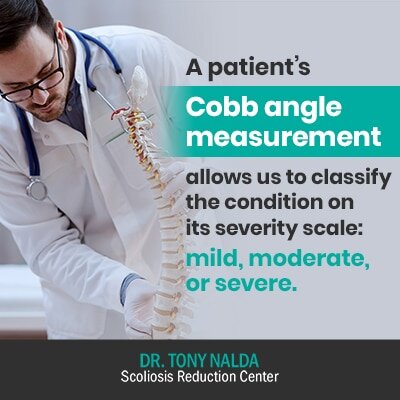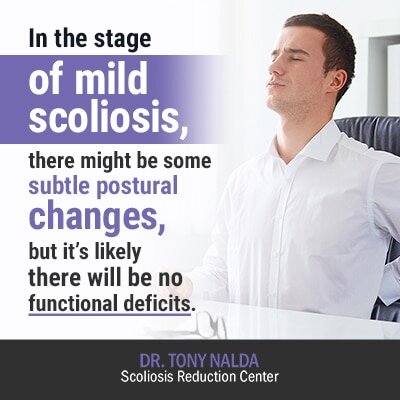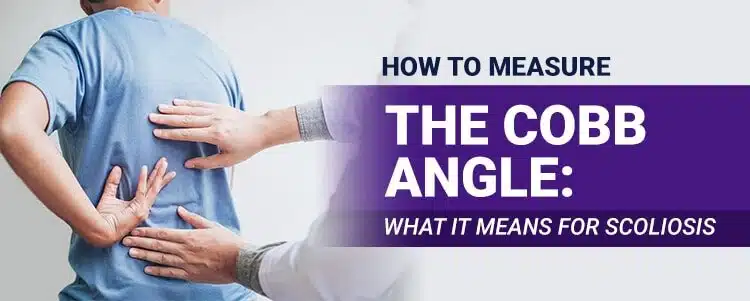There are various methods for diagnosing and assessing scoliosis, but the gold standard is a measurement known as the ‘Cobb angle’. The Cobb angle measured in a scoliosis X-ray tells us important information about their condition and its severity. The Cobb angle is measured from the most-tilted vertebrae of the curvature, and this measurement, in degrees, tells us how far out of alignment the patient’s spine is.
Before we move on to the details of how a Cobb angle is measured and how that information guides our treatment approach, let’s first make sure we have a basic understanding of what it means to have a spine that is out of alignment.
4 Key Takeaways
- Cobb Angle’s Role in Scoliosis Assessment: The Cobb angle is the orthopedic gold standard for diagnosing and assessing scoliosis severity. Measured in degrees, it provides crucial information on how far a patient’s spine deviates from normal alignment, guiding treatment approaches.
- Impact of Scoliosis on Spinal Alignment: Scoliosis causes a loss of the spine’s natural curves, leading to misalignment and affecting the biomechanics of the entire spine. Treatment aims to address these curvatures and their comprehensive impact to restore alignment and function.
- Variability and Treatment Customization: Scoliosis presents in various forms and severity levels, necessitating a fully customized treatment plan. The Cobb angle measurement is instrumental in determining the condition’s severity and tailoring treatment to the individual’s specific needs.
- Severity Classification and Symptoms: Based on the Cobb angle, scoliosis is classified into mild, moderate, or severe categories, each with distinct symptoms and treatment challenges. Early detection and treatment are crucial for managing the condition and mitigating progression and the severity of symptoms.
Adolescent Idiopathic Scoliosis and Spinal Alignment
A healthy spine has three natural curves. If you look at it from the side, it will have a soft ‘S’ shape. These natural curves are there for a reason: to make the spine stronger, allow it to distribute force evenly, and to facilitate flexibility.
When scoliosis develops, there is a loss of these healthy curves, and the spine is no longer in alignment. The curvature doesn’t just affect the spine at the site of its development; it throws off the biomechanics of the entire spine. This is why, our treatment here at the Scoliosis Reduction Center®, involves addressing the curvature and its effects on the entire spine.
Scoliosis is progressive, meaning its nature is to worsen over time. If left untreated, it’s even more likely that a curvature will progress at a faster pace. When engaging in active treatment, the goal is to achieve a curvature reduction, restoring as much of the spine’s healthy curves as possible, and to work towards sustaining those results.
Identifying the curve apex is crucial as its location can impact the severity of the condition and associated risks.
One of the big treatment challenges associated with scoliosis is how much each case varies. There is no general treatment plan that will work to treat scoliosis patients because scoliosis is such a complex condition that takes many forms.
The reason scoliosis X-rays are so important is because they help us monitor the condition and its progressive line. They also tell us everything we need to know about the condition’s characteristics; this information becomes the roadmap for our treatment approach. As every condition is different, they necessitate a fully customized treatment approach.
One of the most important pieces of information gleaned from a scoliosis X-ray is the Cobb angle.
What is the Cobb Angle?
As mentioned earlier, the Cobb angle refers to a measurement taken via X-ray that tells us how far a scoliosis curvature is out of alignment, compared to a healthy spine. It is measured in degrees, and the higher the Cobb angle, the more severe the condition is considered.
The orthopedic gold standard for assessing scoliosis, the Cobb angle tells us just how severe a patient’s condition is, symptoms they are likely to experience, and how we should approach treatment.
Ensuring that the same Cobb angle is measured consistently across different methods is crucial for accurate diagnosis and treatment planning.
How to Measure the Cobb Angle
Based on the X-ray images taken from a variety of angles, Cobb angles are measured by drawing lines along the superior tilted vertebra’s top and the inferior tilted vertebra’s bottom. This method involves drawing lines that are perpendicular to the upper endplate of the uppermost vertebra and the lower endplate of the lowest vertebra. Next, two additional lines are drawn perpendicular at a 90-degree angle to the first lines so they intersect.
Where these sets of lines intersect is the angle that is measured, in degrees, known as the Cobb angle. It is important to note that measuring error can occur due to factors such as patient positioning and the quality of the radiograph. This information is important to understanding the nature of the patient’s condition as a whole.
Various techniques are used to measure the Cobb angle, each with its own limitations and advantages.
Interpreting Cobb Angle Measurements
Interpreting Cobb angle measurements is crucial in assessing the severity of scoliosis and determining the appropriate treatment plan.
A Cobb angle of 10-20 degrees is considered the minimum angulation to define scoliosis. Patients within this range typically have mild scoliosis and may not require immediate intervention but should be monitored regularly to track any curve progression.
When the Cobb angle measures between 20-40 degrees, it indicates moderate scoliosis, where more proactive treatments like physical therapy or bracing might be necessary. A Cobb angle greater than 40 degrees is classified as severe scoliosis, often necessitating more intensive treatments, including the possibility of surgery.
It’s important to note that Cobb angle measurements can be influenced by various factors, such as the patient’s position during the X-ray, the quality of the radiograph, and the experience of the person measuring the angle.
Cobb Angle Measurement in Scoliosis Diagnosis
Cobb angle measurement is a cornerstone in the diagnosis of scoliosis, providing a clear picture of the spinal curvature’s severity.
A Cobb angle of 10-20 degrees is the threshold for diagnosing scoliosis, and patients with this degree of curvature may not need specific treatment but should have regular check-ups to monitor any changes.
For those with a Cobb angle greater than 20 degrees, more active interventions like physical therapy, bracing, or even surgery might be required to manage the curvature effectively.
This measurement helps healthcare providers tailor treatment plans to the individual needs of each patient, ensuring the best possible outcomes.
Factors Affecting Cobb Angle Measurements
Several factors can affect the accuracy of Cobb angle measurements. The patient’s position during the X-ray is crucial; any slight movement can alter the angle. The quality of the radiograph also plays a significant role—clear, high-quality images are essential for precise measurements. Additionally, the experience and expertise of the person measuring the angle can impact the results.
Adolescent idiopathic scoliosis (AIS), the most common type of scoliosis, is characterized by a Cobb angle greater than 10 degrees and can progress rapidly during adolescence. Other spinal deformities, such as kyphosis or lordosis, and the patient’s overall health status can also influence Cobb angle measurements, making it essential to consider these factors for accurate assessment.
Alternative Methods of Measuring Spinal Curvature
While the Cobb angle measurement is the gold standard for assessing spinal curvature, alternative methods are being explored. 3D imaging techniques, such as CT or MRI scans, offer a more comprehensive view of the spine, potentially providing more accurate assessments.
Some researchers have proposed using a horizontal line to measure the curvature, which could offer a different perspective on spinal alignment. However, these alternative methods are not yet widely accepted in clinical practice. The Cobb angle method remains the most trusted and widely used technique for measuring scoliosis, thanks to its simplicity and reliability.
Clinical Applications of Cobb Angle Measurement
Cobb angle measurement has several critical applications in the clinical management of scoliosis. It helps determine the severity of the curvature, guiding the choice of treatment—whether it be observation, physical therapy, bracing, or surgery.
Monitoring the Cobb angle over time allows healthcare providers to track the progression of the curve and assess the effectiveness of treatments. In cases where the Cobb angle exceeds 40 degrees, surgical intervention may be considered to correct the curvature and prevent further complications. This measurement is an invaluable tool in both diagnosing and managing scoliosis.
Limitations of Cobb Angle Measurement
Despite its widespread use, Cobb angle measurement has several limitations. One significant issue is the potential for measurement error, which can arise from the patient’s position during the X-ray, the quality of the radiograph, and the experience of the person measuring the angle. Additionally, the Cobb angle is a two-dimensional measurement and may not fully capture the three-dimensional nature of spinal curvature.
This limitation can be particularly challenging in patients with complex or severe scoliosis, where alternative measurement techniques might be more appropriate. Understanding these limitations is crucial for accurate diagnosis and effective treatment planning.
What the Cobb Angle Means for Scoliosis

A patient’s Cobb angle measurement allows us to classify the condition on its severity scale: mild, moderate, or severe.
Measurements can vary even for the same patient due to factors like patient positioning and the measurement technique used.
Mild scoliosis: Cobb angle measurement of 25 degrees or less
Moderate scoliosis: Cobb angle measurement between 25 and 40 degrees
Severe scoliosis: Cobb angle measurement of 40+ degrees
Classifying a condition helps us understand its characteristics: what symptoms a patient is likely to experience, likely rates of progression, and how intense any treatment plan will have to be to achieve a curvature reduction.
Mild Scoliosis
In cases of mild scoliosis, we know that their symptoms will be mild, and in many cases, are only noticeable to scoliosis specialists who know what to look for. This is why early detection can be such a challenge.
We know that treatment initiated earlier on in the condition’s progressive line is more likely to be successful as the spine will still have a fair amount of flexibility, making it more malleable and easier to manipulate.

As a curvature progresses, the spine gets more rigid, meaning there will likely need to be some mobility work done prior to moving on to curvature reduction.
In the stage of mild scoliosis, there might be some subtle postural changes, but it’s likely there will be no functional deficits.
Moderate Scoliosis
In the moderate stage of progression, scoliosis symptoms become more noticeable. Postural changes can include uneven shoulders, a rib arch, one hip that seems to sit higher than the other, and arms and legs that seem to hang at different lengths.
At this stage, the condition becomes easier to spot for average people, and sometimes changes to gait are also present. There are still rarely functional deficits at this point, and symptoms will also vary depending on the age of the patient.
At this stage, additional complications like pain can be present, but more so in cases of adult scoliosis. In the condition’s most common form, adolescent idiopathic scoliosis, pain is rarely an issue because growth is still occurring. Prior to reaching skeletal maturity, the spine is constantly experiencing a lengthening motion; when that lengthening motion stops with skeletal maturity, this is when the curvature causes compression on the spine and its surrounding muscles and nerves.
Severe Scoliosis
With severe scoliosis, the changes to posture and gait will be noticeable, and this is most often where functional deficits and related complications can come into play.
In addition to changes to gait and a noticeable overall asymmetry to the body, cases of severe scoliosis are connected to lung impairment, cardiac issues, pain, headaches, and mobility issues.
Increased thoracic kyphosis can result from severe scoliosis, leading to additional complications such as respiratory issues.
In many cases of severe scoliosis, they have been left to progress unimpeded, and it’s not until they become severe enough to produce noticeable symptoms that a diagnosis and treatment are sought out.
If an initial Cobb angle measurement comes back at 40+ degrees, we know it’s likely that the condition has already progressed substantially over time and the level of treatment needed will be intense. We also know that the larger a curvature is, the more likely it is to progress.
Conclusion
Part of diagnosing and assessing a patient’s condition is classifying it based on a number of variables. In addition to age of the patient, location of the curvature, and type of scoliosis, the Cobb angle tells us everything we need to know to effectively treat a condition.
While the earlier treatment is initiated, the better, in terms of prognosis, regardless of the severity level, it’s necessary to engage in active treatment. Although scoliosis is incurable, it’s most certainly treatable.
Here at the Scoliosis Reduction Center®, we customize each and every treatment plan to address characteristics of each individual condition, such as the patient’s Cobb angle/condition severity.
We use multiple treatment disciplines so our patients can benefit from various forms of treatment, and we apportion scoliosis-specific chiropractic, therapy, rehabilitation, and corrective bracing accordingly. As we work with a patient throughout the course of their treatment, we monitor their progressive line and tweak the treatment plan as their condition necessitates.





